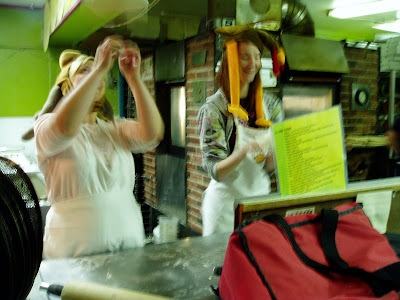
Love on the cheap heats up romance in recession
Tips on how cash-conscious couples can keep the romance in their marriages amid the stress of the economic crisis.
By Melissa Rayworth
The Associated Press
With a recession raging, keeping the romance in a marriage isn't easy. Expenses that many couples considered basic a year ago — dropping $50 on a Friday night baby-sitter, buying each other impromptu gifts, planning weekends away sans-kids — are being eliminated.
Couples lying awake at night wondering whether they'll survive the next round of layoffs probably don't have romance on their minds. These days, "the very last thing on that list of priorities is physical connection," says author and marriage therapist Michele Weiner-Davis.
And yet, the same pressures that have Americans cutting back on expenses — rising costs, fear of losing a job, panic over dwindling savings — make it especially vital for couples to stay connected. Under siege, people need all the benefits that a strong relationship can bring.
So how can cash-conscious couples make sure their marriage isn't a casualty of the economic
crisis?
Carve out time
As over-scheduled as most parents are, it really is possible to find pockets of time to focus on your spouse.
Step One is cutting down on distractions. Don't reflexively reach for your computer, iPod or the remote, says Doug Brown, author of "Just Do It: How One Couple Turned Off the TV and Turned on Their Sex Life for 101 Days (No Excuses!)."
Step Two is getting your kids to bed on time. "If you have one of these deals where the kids float around all night," says Brown, "give up on your sex life."
Call each other during the day just to say hi.
And if you work near each other and your schedules coincide, meet for lunch once a week, even briefly. It may be easier to dine at your desk, but the extra effort pays off.
Plan at least one night a week that will belong entirely to the two of you, and decide how you'll spend the time. "People think you lose all this stuff because you don't have the spontaneity," says Brown. "But planning it does give you this anticipation."
Time together doesn't have to be about wild romance, says sex columnist Yvonne K. Fulbright. "Have one evening where you're giving each other a sensual massage, and it's just about that and a good night's sleep."
Be a cheap date
A night out doesn't have to break your budget. Have dinner at home with the kids, then have a baby-sitter come for just two hours. Go out for dessert and coffee while the sitter does the work of putting the kids to bed. And have a movie chosen to watch when you get home (a monthly Netflix subscription can be cheaper than a single visit to a multiplex).
If there's no money for baby sitters, swap child care hours with friends — you watch their kids this Friday night, they watch yours next Friday. And don't feel guilty about it."
I see people with young children who, because they work so much, they're feeling guilty about spending an evening away or a weekend night away," says Weiner-Davis. "The best thing you can do for your kids is to put your marriage first. ... You may be feeling like you're sneaking away and stealing time, but you're really building the foundation of a family."
Small splurges
Two great steaks from the supermarket butcher will cost far less than you'd pay for dinner at a good steakhouse. Ditto for salmon steaks and jumbo shrimp. Put the little kids to bed early on a Saturday night and set the older kids up with a movie, then cook a late — and luscious — dinner just the two of you. Use your favorite dishes and glassware, and bring out the linen napkins.
If you both have work to do on a weeknight — whether it's folding laundry, returning e-mails or doing homework for a class — do it in the same room. Put on some music and have your favorite small treat on hand — cookies and cocoa, maybe, or beer and chips.
Bring home a single flower or a tiny box of chocolates, says Fulbright: "People shouldn't be afraid to make it old-fashioned, the way lovers used to woo each other."
Create a sanctuary
It doesn't have to cost anything, says Doug Brown, to make your bedroom a cozy, inviting place that's all about the two of you. "You've gotta have candles somewhere around the house," he says. "Just straightening up the place and getting rid of the Dora the Explorer dolls and taking the big portrait of granny off the walls ... makes it a really sexy, friendly kind of place."
Add some framed pictures of the two of you, and make sure you've got some good music on hand — maybe songs from your earliest years together.
The single most important element in all of this, Weiner-Davis says, is communication. Spend time really talking with each other about something other than the kids or the miscellany of running your lives."
Nothing makes you feel more connected to the person than talking about dreams and aspirations and what you can do together in the future," says Weiner-Davis. "There's something really exhilarating and inspiring about planning that together."
Copyright © 2009 The Seattle Times Company


















































